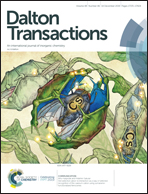A semiconducting supramolecular Co(ii)-metallohydrogel: an efficient catalyst for single-pot aryl–S bond formation at room temperature†
Abstract
A novel mechanically stable supramolecular Co(II)-metallohydrogel has been synthesized. Cobalt(II) nitrate hexahydrate and monoethanolamine, as a low molecular weight organic gelator, are used to get the gel. The mechanical stability of the supramolecular hydrogel was analyzed. The morphology of the supramolecular metallohydrogel was scrutinized. The semiconducting features of the metallohydrogel were studied. The conducting properties of the Co(II)-metallohydrogel establish a Schottky barrier diode type nature. The catalytic nature of the Co(II)-metallohydrogel based room temperature single pot aryl–S coupling reaction was explored. Most interestingly, the Co(II)-metallohydrogel based catalytic aryl–S coupling reaction does not require any column-chromatographic purification protocol to get pure aryl-thioethers. Thus, through this work a semiconducting Schottky barrier diode application and catalytic role in the room temperature single pot aryl–S coupling reaction of a supramolecular Co(II)-metallohydrogel have been explored.



 Please wait while we load your content...
Please wait while we load your content...